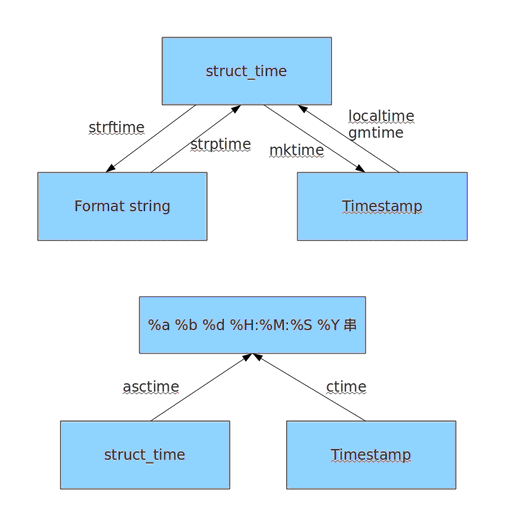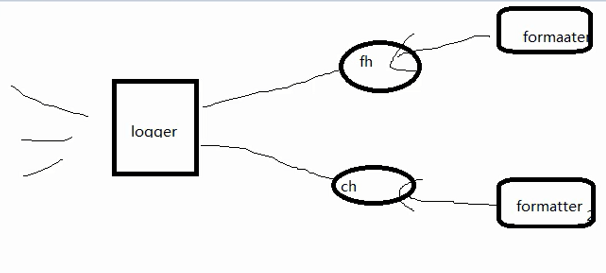python基础六
模块
time &datetime模块
import time # print(time.clock()) #返回处理器时间,3.3开始已废弃 , 改成了time.process_time()测量处理器运算时间,不包括sleep时间,不稳定,mac上测不出来
# print(time.altzone) #返回与utc时间的时间差,以秒计算\
# print(time.asctime()) #返回时间格式"Fri Aug 19 11:14:16 2016",
# print(time.localtime()) #返回本地时间 的struct time对象格式
# print(time.gmtime(time.time()-800000)) #返回utc时间的struc时间对象格式 # print(time.asctime(time.localtime())) #返回时间格式"Fri Aug 19 11:14:16 2016",
#print(time.ctime()) #返回Fri Aug 19 12:38:29 2016 格式, 同上 # 日期字符串 转成 时间戳
# string_2_struct = time.strptime("2016/05/22","%Y/%m/%d") #将 日期字符串 转成 struct时间对象格式
# print(string_2_struct)
# #
# struct_2_stamp = time.mktime(string_2_struct) #将struct时间对象转成时间戳
# print(struct_2_stamp) #将时间戳转为字符串格式
# print(time.gmtime(time.time()-86640)) #将utc时间戳转换成struct_time格式
# print(time.strftime("%Y-%m-%d %H:%M:%S",time.gmtime()) ) #将utc struct_time格式转成指定的字符串格式 #时间加减
import datetime # print(datetime.datetime.now()) #返回 2016-08-19 12:47:03.941925
#print(datetime.date.fromtimestamp(time.time()) ) # 时间戳直接转成日期格式 2016-08-19
# print(datetime.datetime.now() )
# print(datetime.datetime.now() + datetime.timedelta(3)) #当前时间+3天
# print(datetime.datetime.now() + datetime.timedelta(-3)) #当前时间-3天
# print(datetime.datetime.now() + datetime.timedelta(hours=3)) #当前时间+3小时
# print(datetime.datetime.now() + datetime.timedelta(minutes=30)) #当前时间+30分 #
# c_time = datetime.datetime.now()
# print(c_time.replace(minute=3,hour=2)) #时间替换

实例
import time
string_2_struct = time.strptime("13/Mar/2017:11:20:31","%d/%b/%Y:%H:%M:%S") #将 日期字符串 转成 struct时间对象格式
print(time.strftime('%Y-%m-%d %H:%M:%S',string_2_struct)) #将struct时间对象转换成日期字符串
以上代码运行结果
2017-03-13 11:20:31
random模块
import random,string print(random.random())
print(random.randint(1,5))
print(random.randrange(1,5))
print("".join(random.sample('abcdef',2)))
以上代码运行结果:
0.030792454488319798
5
2
fa
生成随机4位数
方法一
import random,string str_source=string.ascii_letters+string.digits
print("".join(random.sample(str_source,4)))
方法二
import random,string import random
checkcode = ''
for i in range(4):
current = random.randrange(0,4)
if current != i:
temp = chr(random.randint(65,90))
else:
temp = random.randint(0,9)
checkcode += str(temp)
print (checkcode)
os模块
os.getcwd() 获取当前工作目录,即当前python脚本工作的目录路径
os.chdir("dirname") 改变当前脚本工作目录;相当于shell下cd
os.curdir 返回当前目录: ('.')
os.pardir 获取当前目录的父目录字符串名:('..')
os.makedirs('dirname1/dirname2') 可生成多层递归目录
os.removedirs('dirname1') 若目录为空,则删除,并递归到上一级目录,如若也为空,则删除,依此类推
os.mkdir('dirname') 生成单级目录;相当于shell中mkdir dirname
os.rmdir('dirname') 删除单级空目录,若目录不为空则无法删除,报错;相当于shell中rmdir dirname
os.listdir('dirname') 列出指定目录下的所有文件和子目录,包括隐藏文件,并以列表方式打印
os.remove() 删除一个文件
os.rename("oldname","newname") 重命名文件/目录
os.stat('path/filename') 获取文件/目录信息
os.sep 输出操作系统特定的路径分隔符,win下为"\\",Linux下为"/"
os.linesep 输出当前平台使用的行终止符,win下为"\t\n",Linux下为"\n"
os.pathsep 输出用于分割文件路径的字符串
os.name 输出字符串指示当前使用平台。win->'nt'; Linux->'posix'
os.system("bash command") 运行shell命令,直接显示
os.environ 获取系统环境变量
os.path.abspath(path) 返回path规范化的绝对路径
os.path.split(path) 将path分割成目录和文件名二元组返回
os.path.dirname(path) 返回path的目录。其实就是os.path.split(path)的第一个元素
os.path.basename(path) 返回path最后的文件名。如何path以/或\结尾,那么就会返回空值。即os.path.split(path)的第二个元素
os.path.exists(path) 如果path存在,返回True;如果path不存在,返回False
os.path.isabs(path) 如果path是绝对路径,返回True
os.path.isfile(path) 如果path是一个存在的文件,返回True。否则返回False
os.path.isdir(path) 如果path是一个存在的目录,则返回True。否则返回False
os.path.join(path1[, path2[, ...]]) 将多个路径组合后返回,第一个绝对路径之前的参数将被忽略
os.path.getatime(path) 返回path所指向的文件或者目录的最后存取时间
os.path.getmtime(path) 返回path所指向的文件或者目录的最后修改时间
shelve模块
import shelve
d= shelve.open('shelve_test') def stu_data(name,age):
print("register stu",name,age) name = ["alex","rain","test"] info ={"name":"alex","age":22} d['test']=name
d["info"]=info
d["func"]=stu_data d.close()
以上代码会产生三个文件:shelve_test.bak;shelve_test.dat;shelve_test.dir
读取产生的三个文件
def stu_data(name,age):
print("register stu",name,age)
d= shelve.open('shelve_test')
print(d.get("test"))
print(d.get("info"))
d["func"]("test",30)
d.close
以上代码运行结果
['alex', 'rain', 'test']
{'name': 'alex', 'age': 22}
register stu test 30
shutil模块
shutil.copyfileobj
将test.txt文件内容拷贝到另一个文件test.txt中,可以部分内容
import shutil
f1=open("test.txt")
f2=open("test_new.txt","w")
shutil.copyfileobj(f1,f2)
将D:\360.7z拷贝到D:\test.7z
import shutil shutil.copyfile(r"D:\360.7z",r"D:\test.7z")
shutil.copy2
拷贝文件和状态信息
将D:\360.7z拷贝到D:\test.7z
import shutil shutil.copy2(r"D:\360.7z",r"D:\test.7z")
shutil.make_archive
将C:\Downloads\Tencent\QQ下的内容打包到D:\test2.tar.gz
import shutil ret=shutil.make_archive(r"d:\test2","gztar",root_dir=r"C:\Downloads\Tencent\QQ")
tarfile模块
C:\QMDownload\SoftMgr里面的内容装在zhou这个文件夹下打包到E:\test1.tar
import tarfile tar = tarfile.open(r"E:\test1.tar",'w') tar.add(r"C:\QMDownload\SoftMgr",arcname="zhou")
tar.close()
C:\QMDownload\SoftMgr里面的内容装在QMDownload\SoftMgr这个文件夹打包到E:\test2.tar
import tarfile tar = tarfile.open(r"E:\test2.tar",'w') tar.add(r"C:\QMDownload\SoftMgr")
tar.close()
xml处理模块
xml是实现不同语言或程序之间进行数据交换的协议,跟json差不多,但json使用起来更简单,不过,古时候,在json还没诞生的黑暗年代,大家只能选择用xml呀,至今很多传统公司如金融行业的很多系统的接口还主要是xml。
xml的格式如下,就是通过<>节点来区别数据结构的:
<?xml version="1.0"?>
<data>
<country name="Liechtenstein">
<rank updated="yes">2</rank>
<year>2008</year>
<gdppc>141100</gdppc>
<neighbor name="Austria" direction="E"/>
<neighbor name="Switzerland" direction="W"/>
</country>
<country name="Singapore">
<rank updated="yes">5</rank>
<year>2011</year>
<gdppc>59900</gdppc>
<neighbor name="Malaysia" direction="N"/>
</country>
<country name="Panama">
<rank updated="yes">69</rank>
<year>2011</year>
<gdppc>13600</gdppc>
<neighbor name="Costa Rica" direction="W"/>
<neighbor name="Colombia" direction="E"/>
</country>
</data>
xml协议在各个语言里的都 是支持的,在python中可以用以下模块操作xml
import xml.etree.ElementTree as ET
tree = ET.parse("xmltest.xml")
root = tree.getroot()
print(root.tag)
#遍历xml文档
for child in root:
print(child.tag, child.attrib)
for i in child:
print(i.tag,i.text)
#只遍历year 节点
for node in root.iter('year'):
print(node.tag,node.tex
修改和删除xml文档内容
import xml.etree.ElementTree as ET
tree = ET.parse("xmltest.xml")
root = tree.getroot()
#修改
for node in root.iter('year'):
new_year = int(node.text) + 1
node.text = str(new_year)
node.set("updated","yes")
tree.write("xmltest.xml")
#删除node
for country in root.findall('country'):
rank = int(country.find('rank').text)
if rank > 50:
root.remove(country)
tree.write('output.xml')
自己创建xml文档
import xml.etree.ElementTree as ET
new_xml = ET.Element("namelist")
name = ET.SubElement(new_xml,"name",attrib={"enrolled":"yes"})
age = ET.SubElement(name,"age",attrib={"checked":"no"})
sex = ET.SubElement(name,"sex")
sex.text = ''
name2 = ET.SubElement(new_xml,"name",attrib={"enrolled":"no"})
age = ET.SubElement(name2,"age")
age.text = ''
et = ET.ElementTree(new_xml) #生成文档对象
et.write("test.xml", encoding="utf-8",xml_declaration=True)
ET.dump(new_xml) #打印生成的格式
ConfigParser模块
用于生成和修改常见配置文档,当前模块的名称在 python 3.x 版本中变更为 configparser。
来看一个好多软件的常见文档格式如下
[DEFAULT]
ServerAliveInterval = 45
Compression = yes
CompressionLevel = 9
ForwardX11 = yes [bitbucket.org]
User = hg [topsecret.server.com]
Port = 50022
ForwardX11 = no
如果想用python生成一个这样的文档怎么做呢?
import configparser config = configparser.ConfigParser()
config["DEFAULT"] = {'ServerAliveInterval': '',
'Compression': 'yes',
'CompressionLevel': ''} config['bitbucket.org'] = {}
config['bitbucket.org']['User'] = 'hg'
config['topsecret.server.com'] = {}
topsecret = config['topsecret.server.com']
topsecret['Host Port'] = '' # mutates the parser
topsecret['ForwardX11'] = 'no' # same here
config['DEFAULT']['ForwardX11'] = 'yes'
with open('example.ini', 'w') as configfile:
config.write(configfile)
读生成的文档里的内容
import configparser config= configparser.ConfigParser()
print(config.sections())
config.read("example.ini")
print(config.sections()) section_name=config.sections()[1] print(config[section_name]["host port"]) for i,v in config[section_name].items():
print(i,v)
以上代码运行结果
[]
['bitbucket.org', 'topsecret.server.com']
50022
host port 50022
forwardx11 no
compressionlevel 9
compression yes
serveraliveinterval 45
configparser增删改查语法
[section1]
k1 = v1
k2:v2 [section2]
k1 = v1 import ConfigParser config = ConfigParser.ConfigParser()
config.read('i.cfg') # ########## 读 ##########
#secs = config.sections()
#print secs
#options = config.options('group2')
#print options #item_list = config.items('group2')
#print item_list #val = config.get('group1','key')
#val = config.getint('group1','key') # ########## 改写 ##########
#sec = config.remove_section('group1')
#config.write(open('i.cfg', "w")) #sec = config.has_section('wupeiqi')
#sec = config.add_section('wupeiqi')
#config.write(open('i.cfg', "w")) #config.set('group2','k1',11111)
#config.write(open('i.cfg', "w")) #config.remove_option('group2','age')
#config.write(open('i.cfg', "w"))
hashlib模块
实例:
import hashlib
# md5加密是不能反解的,但是可以撞库
m=hashlib.md5() # 创建一个md5对象
m.update(b"alex") # 加密字符串'alex'
print(m.hexdigest()) # 显示加密后的随机字符串
m.update(b"li") #"alex"追加一个"li" 组成"alexli"
print(m.hexdigest()) #打印出来的效果和直接hashlib"alexli"一样
m2=hashlib.md5()
m2.update(b"alexli")
print(m2.hexdigest())
以上代码运行结果
534b44a19bf18d20b71ecc4eb77c572f
5f48164ebf9ea14d675ff31bce71c7da
5f48164ebf9ea14d675ff31bce71c7da
用于加密相关的操作,代替了md5模块和sha模块,主要提供 SHA1, SHA224, SHA256, SHA384, SHA512 ,MD5 算法
######## sha1 ######## hash = hashlib.sha1()
hash.update(bytes('admin', encoding='utf-8'))
print(hash.hexdigest()) # ######## sha256 ######## hash = hashlib.sha256()
hash.update(bytes('admin', encoding='utf-8'))
print(hash.hexdigest()) # ######## sha384 ######## hash = hashlib.sha384()
hash.update(bytes('admin', encoding='utf-8'))
print(hash.hexdigest()) # ######## sha512 ######## hash = hashlib.sha512()
hash.update(bytes('admin', encoding='utf-8'))
print(hash.hexdigest())
以上加密算法虽然依然非常厉害,但时候存在缺陷,即:通过撞库可以反解。所以,有必要对加密算法中添加自定义key再来做加密。
import hashlib
# ######## md5 ########
hash = hashlib.md5(bytes('898oaFs09f',encoding="utf-8"))
hash.update(bytes('admin',encoding="utf-8"))
print(hash.hexdigest())
python内置还有一个 hmac 模块,它内部对我们创建 key 和 内容 进行进一步的处理然后再加密
import hmac
h = hmac.new(bytes('898oaFs09f',encoding="utf-8"))
h.update(bytes('admin',encoding="utf-8"))
print(h.hexdigest())
hmac模块
import hmac
h_obj=hmac.new(b"salt",b"hello")
print(h_obj.hexdigest())
以上代码运行结果
3a2484b4f0df4f4157d069598a334b31
logging模块
很多程序都有记录日志的需求,并且日志中包含的信息即有正常的程序访问日志,还可能有错误、警告等信息输出,python的logging模块提供了标准的日志接口,你可以通过它存储各种格式的日志,logging的日志可以分为 debug(), info(), warning(), error() and critical() 5个级别。
日志格式
|
%(name)s |
Logger的名字 |
|
%(levelno)s |
数字形式的日志级别 |
|
%(levelname)s |
文本形式的日志级别 |
|
%(pathname)s |
调用日志输出函数的模块的完整路径名,可能没有 |
|
%(filename)s |
调用日志输出函数的模块的文件名 |
|
%(module)s |
调用日志输出函数的模块名 |
|
%(funcName)s |
调用日志输出函数的函数名 |
|
%(lineno)d |
调用日志输出函数的语句所在的代码行 |
|
%(created)f |
当前时间,用UNIX标准的表示时间的浮 点数表示 |
|
%(relativeCreated)d |
输出日志信息时的,自Logger创建以 来的毫秒数 |
|
%(asctime)s |
字符串形式的当前时间。默认格式是 “2003-07-08 16:49:45,896”。逗号后面的是毫秒 |
|
%(thread)d |
线程ID。可能没有 |
|
%(threadName)s |
线程名。可能没有 |
|
%(process)d |
进程ID。可能没有 |
|
%(message)s |
用户输出的消息 |
实例:
import logging logging.basicConfig(filename="app.log",
level=logging.WARNING,
format='%(asctime)s %(process)d %(filename)s:%(lineno)d %(funcName)s - %(levelname)s: %(message)s',
datefmt='%m/%d/%Y %I:%M:%S %p') logging.debug("test debug")
logging.info("test info ")
logging.warning("user [alex] attempted wrong password more than 3 times")
logging.error("testerror ")
logging.critical("server is down") def app_run():
logging.warning("app has been run too long...")
app_run()
以上代码产生一个app.log文件,app.log文件内容为:
11/16/2016 02:17:08 PM 4684 logging mod.py:10 <module> - WARNING: user [alex] attempted wrong password more than 3 times
11/16/2016 02:17:08 PM 4684 logging mod.py:11 <module> - ERROR: testerror
11/16/2016 02:17:08 PM 4684 logging mod.py:12 <module> - CRITICAL: server is down
11/16/2016 02:17:08 PM 4684 logging mod.py:16 app_run - WARNING: app has been run too long...
logger多输出

import logging # create logger 'TEST-LOG'是自己可以起的名字
logger = logging.getLogger('TEST-LOG')
logger.setLevel(logging.DEBUG) # create console handler and set level to debug
ch = logging.StreamHandler() #屏幕输出
ch.setLevel(logging.WARNING)
#
# # create file handler and set level to warning
fh = logging.FileHandler("access.log",encoding="utf-8") #文件输出
fh.setLevel(logging.ERROR) fh_formatter = logging.Formatter('%(asctime)s %(process)d %(filename)s:%(lineno)d - %(levelname)s: %(message)s')
ch_formatter = logging.Formatter('%(asctime)s - %(name)s - %(levelname)s - %(message)s')
fh.setFormatter(fh_formatter)
ch.setFormatter(ch_formatter) logger.addHandler(fh)
logger.addHandler(ch) logger.warning("warning commint...")
logger.error("error happend..")
以上代码会产生屏幕输出及access.log文件输出
屏幕内容为
2016-11-16 16:41:10,766 - TEST-LOG - WARNING - warning commint...
2016-11-16 16:41:10,766 - TEST-LOG - ERROR - error happend..
access.log文件内容为
2016-11-16 16:41:10,766 10616 logger_多输出.py:24 - ERROR: error happend..
logger文件分割
import logging from logging import handlers logger = logging.getLogger(__name__) log_file = "timelog.log"
# fh = handlers.RotatingFileHandler(filename=log_file,maxBytes=10,backupCount=3,encoding='utf-8')
fh = handlers.TimedRotatingFileHandler(filename=log_file,when="S",interval=5,backupCount=3,encoding='utf-8')
#when="S"指定时间为秒,interval=5指定间隔为5,backupCount=3指定最多分割多少份。 formatter = logging.Formatter('%(asctime)s %(module)s:%(lineno)d %(message)s') fh.setFormatter(formatter) logger.addHandler(fh) logger.warning("test1")
logger.warning("test12")
logger.warning("test13")
logger.warning("test14")
re模块
常用正则表达式符号
'.' 默认匹配除\n之外的任意一个字符,若指定flag DOTALL,则匹配任意字符,包括换行
'^' 匹配字符开头,若指定flags MULTILINE,这种也可以匹配上(r"^a","\nabc\neee",flags=re.MULTILINE)
'$' 匹配字符结尾,或e.search("foo$","bfoo\nsdfsf",flags=re.MULTILINE).group()也可以
'*' 匹配*号前的字符0次或多次,re.findall("ab*","cabb3abcbbac") 结果为['abb', 'ab', 'a']
'+' 匹配前一个字符1次或多次,re.findall("ab+","ab+cd+abb+bba") 结果['ab', 'abb']
'?' 匹配前一个字符1次或0次
'{m}' 匹配前一个字符m次
'{n,m}' 匹配前一个字符n到m次,re.findall("ab{1,3}","abb abc abbcbbb") 结果'abb', 'ab', 'abb']
'|' 匹配|左或|右的字符,re.search("abc|ABC","ABCBabcCD").group() 结果'ABC'
'(...)' 分组匹配,re.search("(abc){2}a(123|456)c", "abcabca456c").group() 结果 abcabca456c '\A' 只从字符开头匹配,re.search("\Aabc","alexabc") 是匹配不到的
'\Z' 匹配字符结尾,同$
'\d' 匹配数字0-9
'\D' 匹配非数字
'\w' 匹配[A-Za-z0-9]
'\W' 匹配非[A-Za-z0-9]
's' 匹配空白字符、\t、\n、\r , re.search("\s+","ab\tc1\n3").group() 结果 '\t' '(?P<name>...)' 分组匹配 re.search("(?P<province>[0-9]{4})(?P<city>[0-9]{2})(?P<birthday>[0-9]{4})","").groupdict("city") 结果{'province': '', 'city': '', 'birthday': ''}
最常用的匹配语法
re.match 从string的开始位置匹配,只有在0位置匹配成功的话才有返回,如果不是开始位置匹配成功的话,match()就返回none
re.search 扫描整个string,返回第一个匹配到的值,匹配不成功返回none
re.findall 把所有匹配到的字符放到以列表中的元素返回
re.split 以匹配到的字符当做列表分隔符
re.sub 匹配字符并替换
反斜杠的困扰
与大多数编程语言相同,正则表达式里使用"\"作为转义字符,这就可能造成反斜杠困扰。假如你需要匹配文本中的字符"\",那么使用编程语言表示的正则表达式里将需要4个反斜杠"\\\\":前两个和后两个分别用于在编程语言里转义成反斜杠,转换成两个反斜杠后再在正则表达式里转义成一个反斜杠。Python里的原生字符串很好地解决了这个问题,这个例子中的正则表达式可以使用r"\\"表示。同样,匹配一个数字的"\\d"可以写成r"\d"。有了原生字符串,你再也不用担心是不是漏写了反斜杠,写出来的表达式也更直观。
仅需轻轻知道的几个匹配模式
re.I(re.IGNORECASE): 忽略大小写(括号内是完整写法,下同)
M(MULTILINE): 多行模式,改变'^'和'$'的行为(参见上图)
S(DOTALL): 点任意匹配模式,改变'.'的行为
序列化
Python中用于序列化的两个模块
- json 用于【字符串】和 【python基本数据类型】 间进行转换
- pickle 用于【python特有的类型】 和 【python基本数据类型】间进行转换
Json模块提供了四个功能:dumps、dump、loads、load
pickle模块提供了四个功能:dumps、dump、loads、load
实例一:
import pickle
data = {'k1':123,'k2':'hello'}
#pickle.dumps 将数据通过特殊的形式转换为只有python语言认识的字符串
p_str = pickle.dumps(data)
print(p_str)
# 反序列化
data = pickle.loads(p_str)
print(data)
实例二:
import pickle
data = {'k1':123,'k2':'hello'}
#pickle.load 将数据通过特殊的形式转换为只有python语言认识的字符串,并写入文件
with open('./result.pk','wb') as f:
pickle.dump(data,f)
#反序列化
with open('./result.pk','rb') as f:
ret = pickle.load(f)
print(ret)
实例三:
import json
data = {'k1':123,'k2':'hello'}
#json.dumps 将数据通过特殊的形式转换为所有程序都能认识的字符串
j_str = json.dumps(data)
print(j_str,type(j_str))
# 反序列化
ret = json.loads(j_str)
print(ret,type(ret))
实例四:
import json
data = {'k1':123,'k2':'hello'}
#json.dump 将数据通过特殊的形式转换为所有程序都认识的字符串,并写入文件
with open('./result.js','w') as f:
json.dump(data,f)
#反序列化
with open('./result.js','r') as f:
ret = json.load(f)
print(ret)
python基础六的更多相关文章
- 【笔记】Python基础六:模块module介绍及常用模块
一,module模块和包的介绍 1,在Python中,一个.py文件就称之为一个模块(Module). 2,使用模块的好处? 最大的好处是大大提高了代码的可维护性 其次,编写代码不必从零开始,我们编写 ...
- python基础(六)循环
作者:Vamei 出处:http://www.cnblogs.com/vamei 欢迎转载,也请保留这段声明.谢谢! 循环用于重复执行一些程序块.从上一讲的选择结构,我们已经看到了如何用缩进来表示程序 ...
- python基础(六)dict字典和文件操作open
字典dict 使用key来标注value的数据类型,key和value是一一对应的.在字典中key是唯一的,所以字典也是无序的. #定义一个字典 dict = { 'name' : 'sylar', ...
- Python基础(六) python生成xml测试报告
思路: 1.使用xslt样式,这样可以很好的和xml结合,做出漂亮的报告 2.生成xml结构 xslt样式是个很有意思,也很强大的,现在用的很多,很方便就能做出一个漂亮的报告,可以百度一下,语法相当简 ...
- python基础六之编码
python中编码的特点: 1,各个编码之间的二进制是不能互相识别的,会产生乱码 2,文件的储存和传输是不能用Unicode的 python3的编码 在python3中字符串在内存中是用Unicode ...
- Python基础(六)
- python 基础(六) 推导式
列表推导式 概念:提供了一种创建列表的简单快速的途径 (1) 一般形式 myList = [x for x in range(10)] #分解后 myList = [] for x in rang ...
- Python基础(六) 函数
.函数 函数是对动作的封装 2.1函数的基本结构 #函数的定义 def 函数名(): #函数提 pass #函数的执行 函数名() 2.2参数初识 #形参 def hanshu(aaa): #参数相当 ...
- 二十六. Python基础(26)--类的内置特殊属性和方法
二十六. Python基础(26)--类的内置特殊属性和方法 ● 知识框架 ● 类的内置方法/魔法方法案例1: 单例设计模式 # 类的魔法方法 # 案例1: 单例设计模式 class Teacher: ...
随机推荐
- Understanding Binomial Confidence Intervals 二项分布的置信区间
Source: Sigma Zone, by Philip Mayfield The Binomial Distribution is commonly used in statistics in a ...
- IP地址查询接口及调用方法
1.查询地址 搜狐IP地址查询接口(IP):http://pv.sohu.com/cityjson 1616 IP地址查询接口(IP+地址):http://w.1616.net/chaxun/ipto ...
- IE 6 全球分布图 - 中国一枝独秀
随着 Windows 8.1 预览版的发布,IE11也与大家见面了,不久后 IE 11 还将登陆 Windows 7 平台.但是,时至今日,在世界的某个地方,仍然有大量的用户在使用老态龙钟的 IE 6 ...
- 2.0 (1)安装MongoDB
(官网:www.mongodb.com) ——————————(1)Mac安装MongoDB———————— 1)安装homebrew (官网地址,brew.sh) ruby -e "$(c ...
- iOS中UI阶段常用的一些方法
UI 即 UserInterface(用户界面 1.iOS系统版本,每年都有更新.对我们开发者而言,主要的是观察API的变化. 2.iPhone新手机发布,会产生不同尺寸的屏幕,现在市面上有4种尺寸, ...
- php 不用四舍五入的方式截取小数点后两位
/** * 字符串截取, 默认小数点后2位 * @param $money * @param int $accuracy * @return float */ private function fil ...
- [转]Java compiler level does not match解决方法
查看链接:http://jingyan.baidu.com/article/95c9d20da3ec5fec4e756186.html
- 【BZOJ-3553】三叉神经树 树链剖分
3553: [Shoi2014]三叉神经树 Time Limit: 160 Sec Memory Limit: 256 MBSubmit: 347 Solved: 112[Submit][Stat ...
- Web项目学习
首先配好jdk,tomcat,下载eclipse,下载bootstrap模板,进行JDBC连接 创建项目 打开Eclipse,选择左上角的File->NEW->最后一个other,选择如下 ...
- jQuery 复习
jQuery 复习 基础知识 1, window.onload $(function(){}); $(document).ready(function(){}); 只执行函数体重的最后一个方法,事 ...
